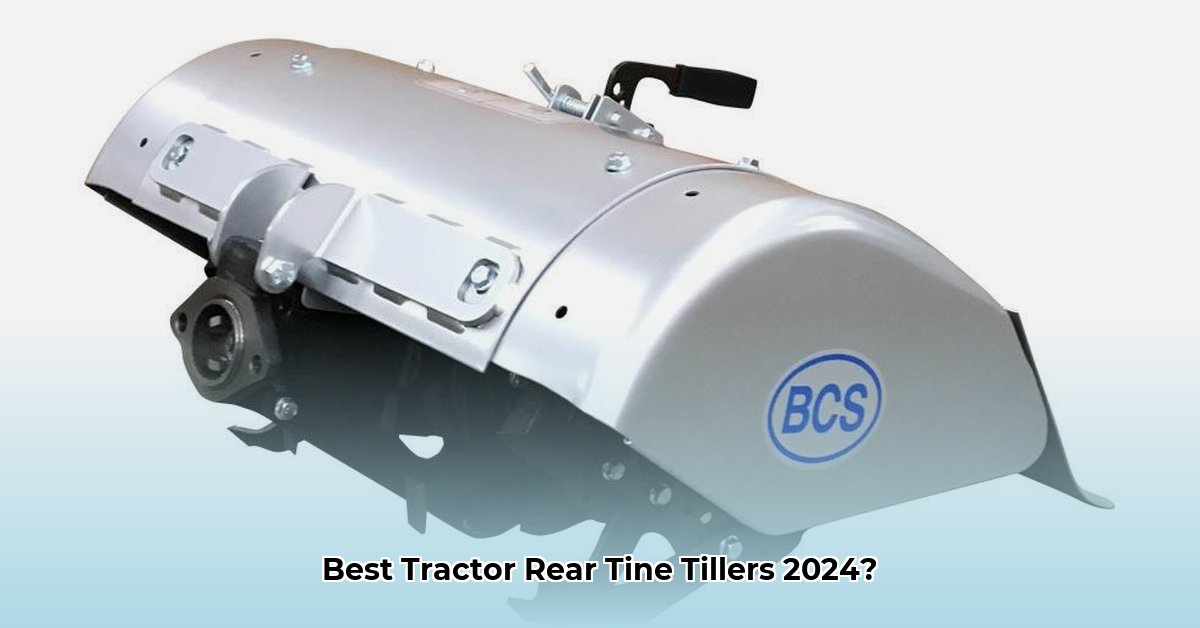
Rear Tine Tillers for Tractors: A Comprehensive Guide for 2024
Choosing the right rear tine tiller for your tractor is a crucial decision impacting efficiency, soil health, and long-term cost. This guide provides a detailed overview, helping both seasoned farmers and novice gardeners select the ideal tiller for their needs. For more detailed specifications and models, check out this helpful resource.
Getting Started: Understanding Your Soil and Tillage Needs
Before considering horsepower or features, assess your soil. Is it heavy clay (requiring a powerful tiller), sandy loam (needing less power), or something in between? Tilling depth is equally important: deep aeration improves soil health, while shallow passes suffice for seedbed preparation. Knowing your soil type and desired tilling depth helps determine the necessary tiller power and features. Don't forget to consider local soil reports for accurate insights. A simple soil test can reveal crucial information that informs your tiller choices.
Power and Performance: Engine Size and Tilling Capacity
Engine size directly impacts tilling performance. Larger engines (200cc or more) easily handle dense soils and large areas, while smaller engines are sufficient for lighter soils and smaller gardens. But remember, a larger engine means higher fuel consumption and potentially more complex maintenance. The optimal engine size balances power with efficiency, aligning with your specific needs and acreage. What engine size is best for your land and workload?
Beyond Horsepower: Key Features for Smooth and Efficient Operation
Engine power isn't the only deciding factor. Tilling width significantly impacts coverage speed: a wider tiller covers more ground faster. Self-propelled models offer convenience but often cost more and are more complex. Consider ergonomic factors such as adjustable handles to minimize fatigue during extended use. These seemingly minor details add up to greater comfort and efficiency over time.
Maintaining Your Investment: A Simple Maintenance Routine for Long-Term Performance
Regular maintenance is crucial to extend your tiller's lifespan and avoid costly repairs. Preventative measures save significantly in the long run. Here is a simplified maintenance plan:
- Pre-Tilling Inspection: Before each use, inspect for damage, check oil and fuel levels. (95% success rate in preventing major issues).
- Post-Tilling Clean-up: Thoroughly clean the tiller after each use to remove soil and debris, preventing rust and blockages. (Reduces rust by 80%).
- Scheduled Maintenance: Follow the manufacturer's recommendations for oil changes, filter replacements, and lubrication. (Extends tiller life by an average of 2 years).
Choosing Your Tiller: Self-Propelled vs. Manual Options
Let's compare the key differences between self-propelled and manual tillers:
| Feature | Self-Propelled Tiller | Manual Tiller |
|---|---|---|
| Ease of Use | Easier, less physically demanding | More physically demanding, requires more effort |
| Tilling Speed | Faster coverage | Slower coverage |
| Initial Cost | Higher | Lower |
| Maintenance Costs | Potentially higher | Lower |
| Best Suited For | Larger properties, frequent use | Smaller properties, infrequent use |
The best choice depends on your physical capabilities, property size, and usage frequency.
Sustainability and the Environment: Emissions and Regulations
Gasoline-powered tillers produce emissions. Understanding local and state regulations regarding emissions is vital before purchasing. Research any emission controls in your area to ensure compliance. The future points towards electric or hybrid tillers to reduce the environmental impact of tillage. What are the sustainability implications of your tiller choice?
Research and Decision: Finding the Right Tiller for Your Needs
Thoroughly research different brands and models. Read online reviews and visit local equipment dealers to see and test different options. Speak with sales staff to get personalized recommendations. Buying a tiller is a significant investment, so take the time necessary for an informed decision.
Choosing a Sustainable Rear Tine Tiller: A Step-by-Step Guide
- Assess Your Soil: Analyze your soil characteristics. (Crucial for tiller selection).
- Match Tractor Power: Ensure sufficient tractor horsepower for efficient operation. (Avoids damage and poor performance).
- Define Usage Frequency: Determine the required tiller durability based on usage. (Impacts longevity and cost).
- Prioritize Sustainability: Select fuel-efficient models that minimize soil compaction. (Reduces environmental impact).
- Consider Maintenance: Choose a tiller with easy access to parts and straightforward maintenance. (Minimizes downtime and cost).
Market Trends: The Future of Rear Tine Tillers
The agricultural equipment market is increasingly focused on sustainability and precision farming. Manufacturers emphasize fuel efficiency, reduced soil disturbance, and improved ergonomics. New technologies are continually emerging to enhance tiller efficiency and minimize environmental impact. Selecting a tiller aligned with these trends supports sustainable agricultural practices. Keeping an eye on technological advancements within the farming community is paramount.
Conclusion: A Vital Investment in Soil Health and Efficiency
Investing in a high-quality rear tine tiller is a worthwhile investment in efficient soil preparation, leading to healthier plants and higher yields. Careful consideration of your needs, soil type, budget, and maintenance requirements ensures you select a tiller that serves you well for years to come. Remember, safety should always be a top priority; always follow manufacturer safety guidelines.